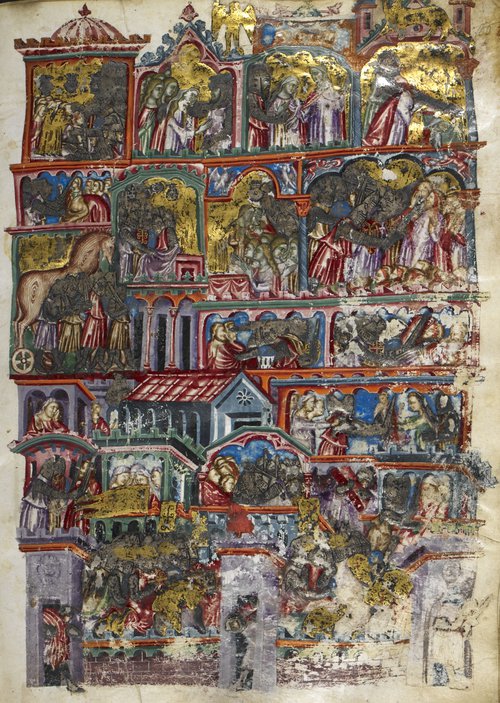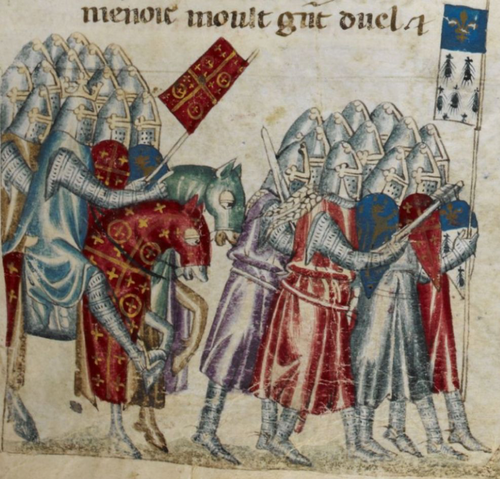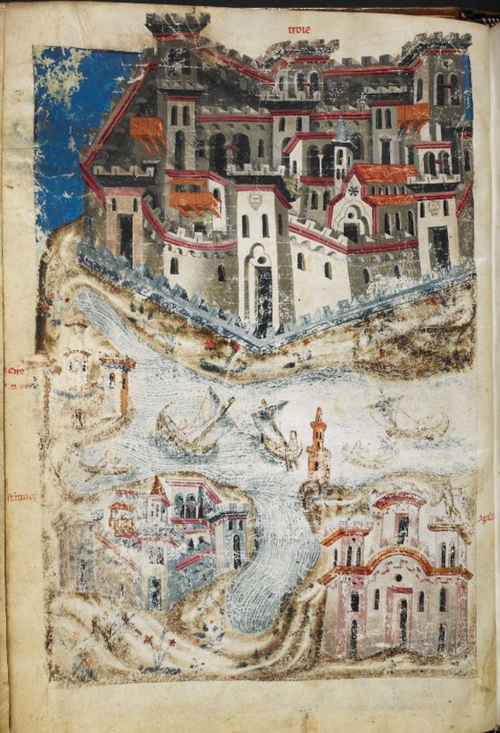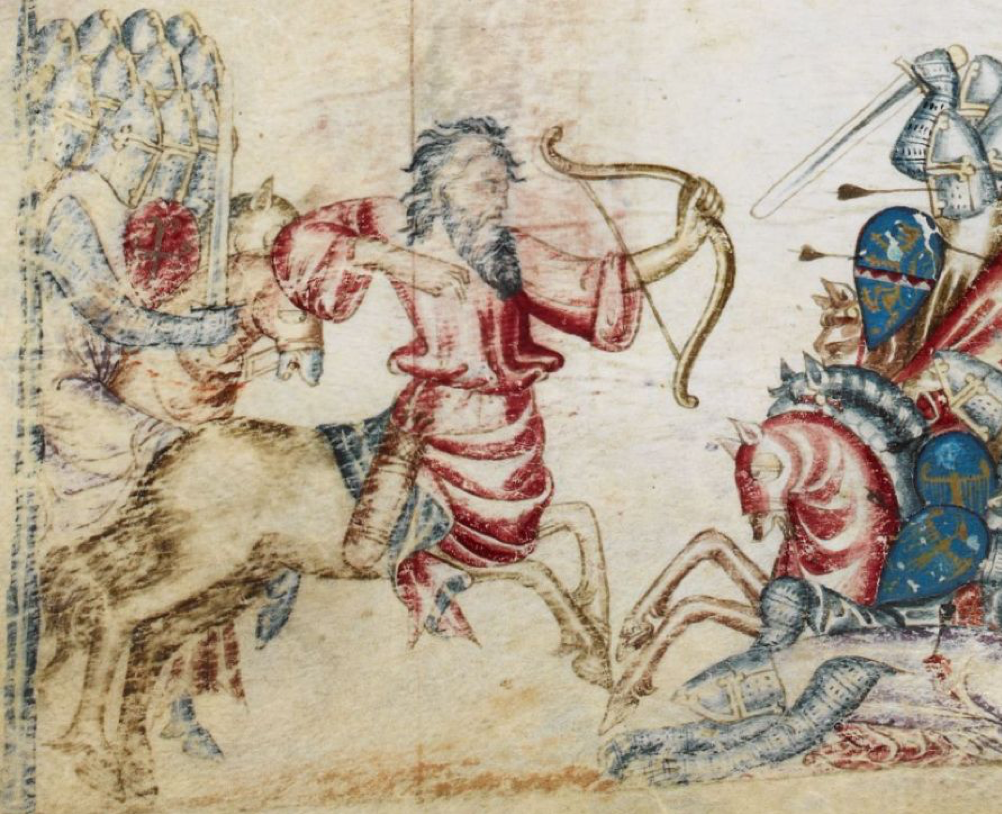The Angevin vision of history in the Histoire ancienne of British Library Royal 20 D I
Luca Barbieri is Lecturer of Medieval French and Occitan at the University of Fribourg (Switzerland) and Senior Research Fellow at the Opera del Vocabolario Italiano in Florence (Italy). He is currently working on the digital edition of the Trojan section of the Histoire ancienne jusqu'à César in British Library Royal 20 D I for TVOF.

The sack of Troy. British Library, Royal 20 D I, f. 169r. Reproduced with permission from the British Library Board.
Every medieval manuscript has a story to tell. That of BL Royal 20 D I is particularly interesting because it shows us that these old parchment volumes were not always kept in dark and dusty libraries, but could have a supporting role in the political action of the rulers and be displayed for propagandistic purposes.
The Angevin dynasty of the kingdom of Naples was particularly active in supporting its political ambitions with the production of texts and manuscripts. The interest of the Italian Angevins in the territories of Outremer and the Latin East is well known. Charles of Anjou (1226–85), founder of the dynasty, had since 1267 expressed his desire to reconquer Constantinople after the Latin Empire fell in 1261. Over the following decade, he proclaimed himself King of Albania, bought the title of King of Jerusalem and also obtained the title of Prince of Achaia. The oldest manuscript of the first prose version of the Roman de Troie (Paris BnF fr. 1612) was compiled in the Frankish Morea at the end of 13th century, and the composition of the text probably took place in the same area in the early years of Angevin domination (1278–1282). The geographical description contained in the initial chapters of the text traces the outlines of “Magna Graecia” coveted by the Angevins, with the eastern lands added to the Italian possessions.
The Royal manuscript was made in Naples during the reign of Robert of Anjou (1275–1343), Charles' grandson, and contains a particular redaction of the Histoire ancienne jusqu'à César, a large historiographical compilation narrating the beginning of the world to the Roman conquest of Gaul. Compared to the older text, the Neapolitan version omits the parts derived from the Bible and the sections dedicated to the Far East, taking the form of a Greco-Roman history that focuses on the Italian and eastern possessions of the Angevins. But the most significant change concerns the Trojan section: the French translation of the short Latin chronicle by Dares Phrygius is replaced by a very long mise en prose of the Roman de Troie (referred to in the scholarship as Prose 5), which gives new importance to the mythical war of antiquity by making it the heart of the new compilation (in the Royal manuscript the Trojan section takes up almost half of the whole text), and includes the translation of 13 epistles from Ovid’s Heroides adapted to the context of the Trojan war. This intention is also confirmed by the rich iconographic apparatus, organized in such a way as to highlight the Trojan section.
Certain textual additions show that this compilation fits into the perspective of continuity with the texts written at the time of Charles of Anjou, while adapting to the needs of contemporary events. In the text of the Royal manuscript, for instance, the compiler adds several references to the island of Kefalonia and the lands of the Despotate of Epirus. In the years between 1318 and 1340, during Robert's reign, these territories were at the centre of a bitter dispute between the crown of Naples, the Orsini family (linked by ties of vassalage to the Angevins but eager for greater autonomy), and the Byzantine Empire.
Yet it is the iconographic apparatus of the Royal manuscript that further reveals the attempt to use ancient history to justify contemporary politics from an ideological and cultural point of view. The codex is richly illustrated, among other things with numerous battle scenes. In contrast to the typical illustrations of Arthurian texts, characterized by fictive heraldry, the warriors of the Royal manuscript instead display recognizable coats of arms linked to the time of its production. The coat of arms of Robert of Anjou recurs several times in all its variants, including that of the titular King of Jerusalem, as well as those of other members of the ruling family. But what is most striking is the particular frequency of two apparently less significant coats of arms: that of Catherine of Valois-Courtenay, consort of Robert’s brother Philip of Anjou and titular empress of Constantinople as well as regent of the kingdom of Achaia, and that of the Orsini family from Kefalonia and Epirus. Also relevant is the fact that the arms of the Angevin entourage identify the Greek warriors as opposed to their Trojan enemies. This representation contrasts with the traditional idea of translatio imperii that depicts Troy as the ideal city of civilization and chivalry, from which the main ruling dynasties in Europe were descended. In the texts, this idea usually translates into an explicit endorsement of the Trojans. The iconography of the Royal manuscript then returns us to the image of an Angevin dynasty that distances itself from its French origins and is rooted in Italian possessions, underlining at the same time its desire for expansion towards the Latin territories of Outremer.

Greek warriors displaying the coats of arms of Catherine of Valois-Courtenay (on the left) and of the Orsini family (on the right). British Library, Royal 20 D I, f. 2v. Reproduced with permission from the British Library Board.
In the final years of Robert's reign the historical conditions that explain the peculiarities of the Royal manuscript become clear. In 1337, the Byzantine emperor Andronicus III (1297–1341) invaded Thessaly demanding the subjugation of Epirus, a region divided between pro-Angevin and pro-Byzantine factions and led by Anne Palaiologina on behalf of her young son Nikephoros Orsini. Some members of the Epirotic aristocracy managed to bring Nikephoros to Italy under the protection of Catherine of Valois-Courtenay. Also worried about the situation of Achaia, of which she was regent due to the minority of her son Robert, Catherine organised a campaign in Morea to strengthen control of the region and favour the reconquest of Epirus by Nikephoros. This campaign kept her busy on Greek soil from November 1338 until the middle of 1341.
The presence in the illustrations of the Royal manuscript of the arms of the Orsini of Kefalonia and of Catherine of Valois-Courtenay together with those of Robert of Anjou suggests that the manuscript was conceived as an instrument of propaganda in preparation for the Morea campaign, allowing us to fix the date of its compilation to 1337 or 1338, when Nikephoros Orsini was in Naples.

The Bosphorus Strait with the cities of Troy and Constantinople. British Library, Royal 20 D I, f. 26v. Reproduced with permission from the British Library Board.
But there is one last element of a cultural character that deserves to be highlighted. A full-page miniature placed at the beginning of the Trojan section of the Royal manuscript presents an aerial view of the city of Troy surrounded by three other coastal cities. When we compare this image with a modern map of the Bosphorus, we cannot fail to be struck by its geographical accuracy. Familiarity with the region, begun at the time of the Fourth Crusade, and the contemporary development of cartographic art, which found fertile ground in Naples, explains this effort at realism. At the same time, however, the image presents contradictory elements that suggest a symbolic interpretation. The city of Troy, for example, is unnaturally placed right in front of Constantinople, in the position that corresponds to Scutari, on the Asian coast of the Bosphorus.
This iconographic feature confirms certain textual additions that seem to indicate an identification of Troy with Constantinople. The description of the ancient city of Troy, for example, is clearly inspired by that of Constantinople found in some chronicles of the Crusades (for example the Directorium ad passagium faciendum by Brocardus and the Historia rerum in partibus transmarinis gestarum by William of Tyre). In light of this, the identification of the Angevins with the Greeks also takes on a clearer meaning. The Royal manuscript would fit into the continuity of the cultural context of the Crusades, with the Angevins of Naples representing the champions of Western Christian civilization, while numerous elements show an “orientalisation” of Troy and the Trojans, with the feeling of disturbing otherness that this association entails (see for example the description of the Sagittarius brought into battle by an ally of the Trojans). The overlap of Troy and Constantinople allows us to interpret the mythical war as a metaphor for the opposition of the Angevins against Byzantine enemies, to whom are attributed the same “oriental” and disturbing traits that the Royal manuscript attributes to the Trojans.
The uniqueness of the Royal manuscript, which, through various textual and iconographic elements, is anchored in an extremely precise historical situation, also explains why the second redaction of the Histoire ancienne jusqu'à César did not enjoy later success. Indeed, the manuscripts that contain it, all French and compiled in the 15th and 16th centuries, strive to dismantle the original project through linguistic normalization, structural fragmentation and above all a return to more conventional iconography. In doing so, they progressively eliminate the significant images of the Neapolitan manuscript, too closely linked to a place and a moment in time. By the time these manuscripts were copied, the Angevin kingdom of Naples no longer existed.
Bibliography
Barbieri, Luca, “Roman de Troie”, in Nouveau répertoire des mises en prose (XIVe siècle), sous la direction de Maria Colombo-Timelli, Barbara Ferrari, Anne Schoysman et François Suard, Paris, Classiques Garnier, 2014, 773-848
Barbieri, Luca, “La versione ‘angioina’ dell’Histoire ancienne jusqu’à César. Napoli crocevia tra cultura francese e Oriente latino”, Francigena, 5 (2019), 1-26
Cipollaro, Costanza, “Una galleria di battaglie per Roberto d’Angiò: nuove riflessioni su l’Histoire ancienne jusqu’à César di Londra (British Library, MS. Royal 20 D I)”, Rivista d’arte, s. V, 3 (2013), 1-34.
Desmond, Marilynn, “Translatio imperii and the Matter of Troy in Angevin Naples: BL Royal MS 20 D I and Royal MS 6 E IX”, Italian Studies, 72/2 (2017), 177-191
Desmond, Marilynn, “Magna Graecia and the Matter of Troy in the Francophone Mediterranean”, in Medieval Francophone Literary Culture Outside France: Studies in the Moving Word, ed. by Nicola Morato and Dirk Schoenaers, Turnhout, Brepols, 2018, 411-431
Rochebouet, Anne, “D’une pel toute entiere sans nulle cousture”: la cinquième mise en prose du Roman de Troie, édition critique et commentaire, Thèse de doctorat de l’Université de Paris-Sorbonne, 2009
Rochebouet, Anne, “De la Terre Sainte au Val de Loire: diffusion et remaniement de l’Histoire ancienne jusqu’à César au XVe siècle”, Romania 134 (2016), 169-203
Tanniou, Florence, “De l’Orient rêvé à l’Orient révélé: les mutations de l’exotisme du Roman de Troie de Benoît de Sainte-Maure au Roman de Troie en prose (Prose 1)”, Bien dire et bien aprandre, 26 (2008), 213-226
Tanniou, Florence, Raconter la vraie estoire de Troye. Histoire et édification dans le Roman de Troie en prose (Prose 1, version commune), Thèse de doctorat, Université de Paris X-Nanterre, 2009
Tanniou, Florence, “Troie, sur le chemin des croisades (XIIe-XIVe siècles)”, in La légende de Troie de l’Antiquité Tardive au Moyen Âge. Variations, innovations, modifications et réécritures, ed. Eugenio Amato, Élisabeth Gaucher-Rémond, Giampiero Scafoglio, Atlantide, 2 (2014), 3-9 <http://atlantide.univ-nantes.fr>

The Sagittarius. British Library, Royal 20 D I, f. 94v. Reproduced with permission from the British Library Board.